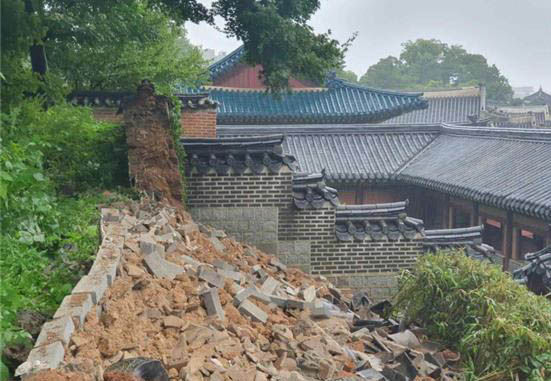Buildings, ancient relics, and cultural relics were also difficult to recover from the flood, which was destroyed and soaked by the flood, and the village walls were washed away by the flood and the soil and stone. Among them, the village walls and stone tablets of the private mountain town with a history of 1,500 years were maintained by the heavy rain, and the royal tombs were also lost due to the heavy rain.

34 pieces of China’s cultural heritage were maintained
South Korean media “News1”, “Newsis News Agency” reported that the South Korean Civilization and Finance Department today said that because of this wave of rain, from June 23 this year to this month as of 16, a total of 34 national civilization heritage was maintained. Among them, eight are in North Gyeongsang Province and seven are in South Chungcheong Province, including one treasure, 19 historic sites, five natural (natural) monuments, three scenic spots, five national customs and cultural treasures, and one registered cultural treasures.
Located in Munju, South Chungcheong Province, the town of Munsan has a history of 1,500 years and has been inscribed by UNESCO as a part of the “Baekje Historical Site” of the world Heritage. It was the capital of Baekje from 475 to 538 AD during The Three Kingdoms of Joseon (Goguryeo, Silla, and Baekje, from the 1st century BC to the 7th century BC). King Jangsu of Goguryeo captured the Baekje capital of Weili Township (Han Township) in the Han River valley. After the death of King Gaelo of Baekje, King Munju, son of King Gaelo of Baekje, moved his capital to Xiongjin.
The rear wall of Changdeokgung Palace, Seoul
▲ The wall behind the palace of Tyranny in Changdeok Palace in Seoul collapsed due to heavy rain. Korea Cultural Wealth Department
“Banhe building” to the top of many rivers
Musan Township was originally a Tuju township, then expanded to Seok-township, and was also a military fortress during the Silla, Goryeo, and Joseon dynasties.
This wave of heavy rain led to the loss of private mountain township wall soil and stone, built in the township wall of the pavilion “Wan River building” more covered to many Jinjiang river water roof, until the water level into the back finally re-exposed no real face, the other end of the township wall of the pavilion “Jinxi building” lower end of the earth, rubble was also washed by heavy rain, nearby live many stone tablets were washed away, the city staff quickly opened with giant tarp, The mausoleum of King Wuning and the king mausoleum in Baekje, Buju, were also lost.
Sabii (Buo County, South Chungcheong Province), also the capital city of the late Baekje period, also suffered heavy rain, and the ancient tombs of House No. 2 on the west side of the Buo King mausoleum, where many tombs of Kings were scattered, were scattered.
The excavation site of Seokjang-ri, a Paleolithic site in Munju, South Chungcheong Province, was also submerged in water. The Seokjang-ri Museum was not allowed to enter the site, and its cultural relics were moved to a safe area.
In Hwasang, Gyeonggi Province, heavy rain washed away the town
The mud and rocks in the drainage channel of the First Gate of the ancient civilization in North Gyeongsang Province have been scattered, and the earth wall built in the Hagui village in Andong, North Gyeongsang Province has suffered heavy rain maintenance.
As for the metropolitan area, there are also flashes of the preservation of civilization, located in Hwasang City, Gyeonggi Province, Dang township (also known as Dang township, Dang hang township) about 3 private feet of the outer edge of the township wall was washed away by heavy rain; The Changdeok Palace, one of the five ancient palaces in Seoul during the Korean period, was also subjected to heavy rain maintenance, and 15 private feet of the flower terrace stone wall of the Hall of tyranny were washed away by heavy rain.
In addition, the three-story stone pagoda in Shincheon, Yeonggwang-gun, South Jeolla Province, which was built 1,000 years ago in the early Goryeo period, was directly protected from damage, but the 10 stone walls between the two private measures of the pagoda collapsed due to heavy rain.